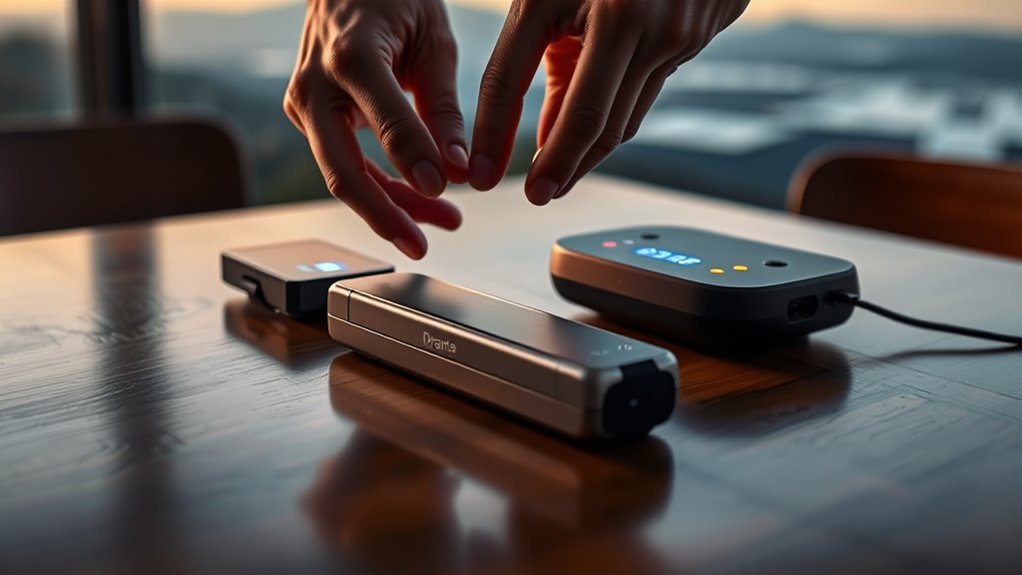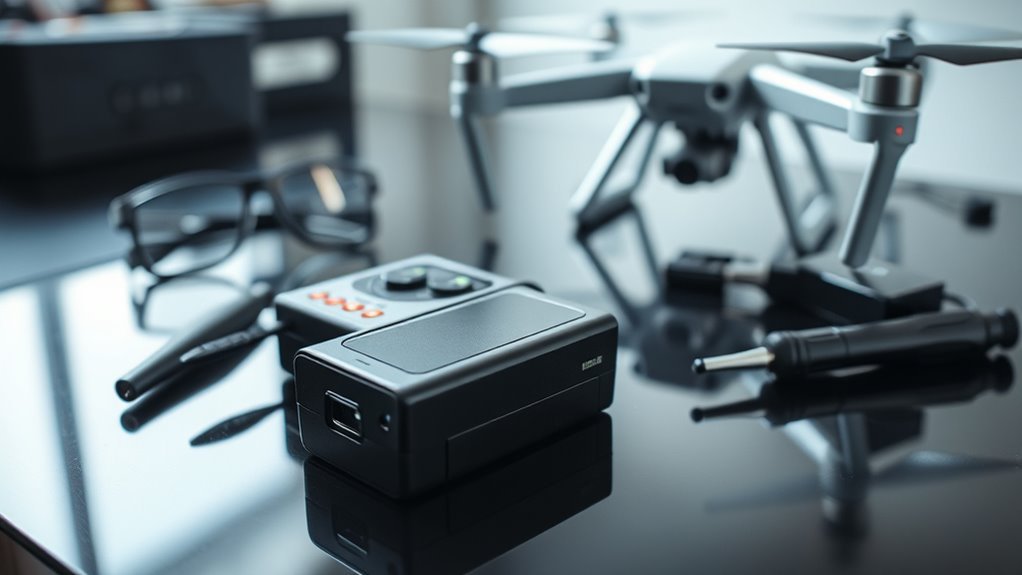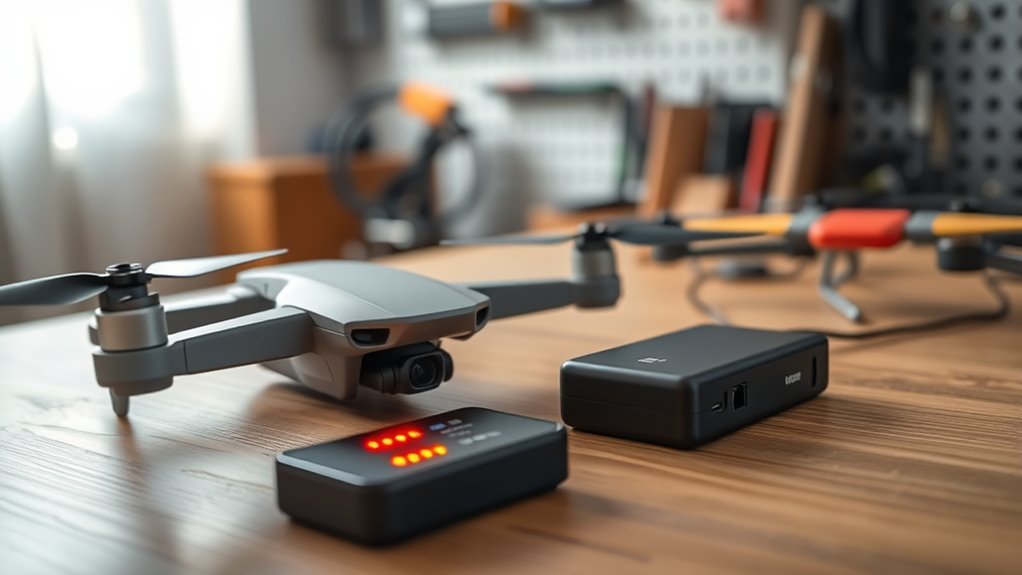To charge your drone battery, first, check its type—lithium polymer (LiPo) or nickel cadmium (NiCd). Gather compatible charging equipment and guarantee everything is in good condition. Charge in a fireproof area and monitor the temperature. Avoid overcharging by following manufacturer guidelines, and keep the drone powered off during the process. Regularly check the battery’s health to maintain performance. Follow these steps, and you’ll discover effective techniques for keeping your batteries in top shape.
Understanding Drone Battery Types

When it comes to flying drones, understanding the different types of batteries is essential for ideal performance. Two primary types you’ll encounter are lithium polymer (LiPo) and nickel cadmium (NiCd). LiPo batteries are popular due to their lightweight design and high energy density, providing longer flight times and faster charging. They’re perfect if you crave extended aerial adventures. On the other hand, NiCd batteries are more robust and can withstand more charge cycles, making them suitable for beginners. However, they tend to be heavier and have lower energy density, which can limit flight duration. Knowing these differences helps you choose the best battery for your drone, ensuring you enjoy the freedom of flight without any hitches. Additionally, understanding advanced battery optimization techniques can help maximize your drone’s performance and longevity.
Preparing for Charging

Before you start charging your drone battery, it’s important to prepare properly to guarantee safety and efficiency. First, check your battery capacity; knowing how much charge your battery can hold helps you avoid overcharging. Gather the appropriate charging equipment, making sure it’s compatible with your drone’s battery type. Inspect the charging cables and connectors for any damage or wear. A clean workspace is crucial; make sure it’s free from dust and moisture to prevent any hazards. If you’re using a smart charger, familiarize yourself with its settings so you can optimize the charging process. Finally, confirm your drone is powered off during charging to protect its internal components and battery performance. With these preparations, you’re ready to charge your battery safely.
Charging the Battery Safely

To guarantee a safe charging process for your drone battery, always follow the manufacturer’s guidelines and use the correct charger. Here are some essential safety precautions to keep in mind:
| Safety Precautions | Charging Equipment | Tips |
|---|---|---|
| Charge in a fireproof area | Use the right voltage | Don’t leave unattended |
| Avoid charging on flammable surfaces | Inspect cables regularly | Monitor temperature |
| Keep away from children | Use original chargers | Don’t overcharge |
| Store batteries properly | ascertain good ventilation | Disconnect when charged |
Additionally, remember that different drones, like the Potensic Atom 2 and Autel EVO II Dual, have varying battery life specifications that can influence how often you need to charge.
Monitoring Battery Health
Monitoring your drone battery’s health is essential for ensuring ideal performance and longevity, especially since neglecting it can lead to unexpected failures. Regularly checking the battery’s health helps you assess its lifespan and avoid surprises during your flights. You should keep track of its charge cycles and discharge patterns, as these impact overall capacity management. If you notice a significant drop in capacity, it might be time to replace the battery. You can also use battery management systems or apps that provide real-time diagnostics, giving you insights into voltage levels and temperature. By staying proactive in monitoring, you can enjoy more freedom during your flights without the worry of battery-related issues.
Best Practices for Battery Maintenance
While you’re enjoying your drone flights, keeping up with battery maintenance is crucial for ideal performance. To maximize your battery lifespan, always store your batteries at around 50% charge when not in use. Avoid letting them drop below 20% during flights, as deep discharges can damage them. Regularly inspect for any signs of swelling or damage, and replace batteries that show these issues. Additionally, keep your batteries clean and dry; dirt or moisture can lead to malfunctions. Use a smart charger designed for your battery type, as it guarantees proper charging and enhances longevity. Following these maintenance tips will help you keep your batteries in top shape, allowing you to enjoy endless aerial adventures without worry. Furthermore, consider the flight time capabilities of your drone model, as longer durations can impact your usage and charging schedules. The EXO Blackhawk 3 stands out with its impressive flight time, which significantly enhances your aerial experience.
Frequently Asked Questions
Can I Use a Different Charger for My Drone Battery?
You shouldn’t use a different charger for your drone battery unless it matches the charger compatibility and battery voltage requirements. Mismatched chargers can damage your battery, leading to poor performance or safety hazards. Always verify first.
How Long Does a Drone Battery Typically Last?
Imagine soaring through the skies; a drone’s battery lifespan typically ranges from 20 to 30 minutes, depending on the model and conditions. Your flight duration can vary, so plan accordingly to maximize your aerial adventures.
What Happens if I Overcharge My Drone Battery?
If you overcharge your drone battery, it can lead to overheating, reduced lifespan, or even battery failure. For battery safety, follow charging tips closely and always use a compatible charger to prevent potential hazards.
Can I Charge My Drone Battery in Extreme Temperatures?
Can you really charge your drone battery in extreme temperatures? It’s not safe! Temperature effects can damage your battery. Always prioritize charging safety and guarantee you’re in a suitable environment to protect your investment.
Is It Safe to Leave My Battery Charging Overnight?
Leaving your battery charging overnight isn’t recommended due to battery safety concerns. It’s better to monitor the charging process and disconnect it once fully charged to prevent overheating or potential damage. Stay safe and informed!

